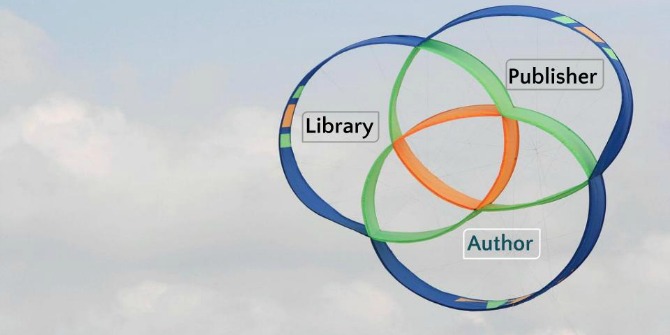
 Although predatory publishers pre-date open access, their recent explosion was expedited by the emergence of fee-charging OA journals. Monica Berger and Jill Cirasella argue that librarians can play an important role in helping researchers to avoid becoming prey. But there remains ambiguity over what makes a publisher predatory. Librarians can help to counteract the misconceptions and alarmism that stymie the acceptance of OA.
Although predatory publishers pre-date open access, their recent explosion was expedited by the emergence of fee-charging OA journals. Monica Berger and Jill Cirasella argue that librarians can play an important role in helping researchers to avoid becoming prey. But there remains ambiguity over what makes a publisher predatory. Librarians can help to counteract the misconceptions and alarmism that stymie the acceptance of OA.
If you have even a fleeting interest in the evolving landscape of scholarly communication, you’ve probably heard of predatory open access (OA) journals. These are OA journals that exist for the sole purpose of profit, not the dissemination of high-quality research findings and furtherance of knowledge. These predators generate profits by charging author fees, also known as article processing charges (APCs), that far exceed the cost of running their low-quality, fly-by-night operations.
Charging a fee is not itself a marker of a predatory publisher: many reputable OA journals use APCs to cover costs, especially in fields where research is often funded by grants. (Many subscription-based journals also charge authors fees, sometimes per page or illustration.) However, predatory journals are primarily fee-collecting operations—they exist for that purpose and only incidentally publish articles, generally without rigorous peer review, despite claims to the contrary.
Of course, low-quality publishing is not new. There have long been opportunistic publishers (e.g., vanity presses and sellers of public domain content) and deceptive publishing practices (e.g., yellow journalism and advertisements formatted to look like articles). It is also not unique to OA journals. There are many mediocre subscription-based journals, and even respected subscription-based journals have accepted deeply problematic submissions (e.g., Andrew Wakefield et al.’s article linking autism to vaccines in The Lancet and Alan Sokal’s nonsense article in Social Text).
Although predatory publishers predate OA, their recent explosion was expedited by the emergence and success of fee-charging OA journals. No matter how strong our urge to support and defend OA, librarians cannot deny the profusion of predators in the OA arena; John Bohannon’s recent “sting” made abundantly clear (despite methodological flaws) that there are many bad actors. Rather, we should seek to understand their methods, track their evolution, and communicate their characteristics to our patrons.
Blacklists, whitelists, and other defenses against predatory publishers
The highest-profile watchdog of predatory publishers is Jeffrey Beall, a librarian at the University of Colorado-Denver, who curates a blacklist of “potential, possible, or probable” predatory OA publishers and journals. Beall’s list has become a go-to tool and has even been featured in The New York Times, but it is not the final word on predatory publishing, partially because Beall himself has a complicated, and not entirely supportive, attitude toward OA in general.
 Image credit:Yael P (Flickr, CC BY)
Image credit:Yael P (Flickr, CC BY)
Without a doubt, Beall has amassed considerable knowledge and greatly increased awareness of predatory publishing. He is recognized as a leading expert and has gone largely unchallenged, probably both because nonexperts are eager for blacklists that seemingly obviate the need for individual analysis of publishers and journals, and because little empirical research has been done on the phenomenon of predatory publishing. However, in 2014, Walt Crawford took Beall to task in an article called “Ethics and Access 1: The Sad Case of Jeffrey Beall.“
Crawford criticizes Beall for not contextualizing predatory or low-quality publishing as a phenomenon that predates OA and is not exclusive to OA journals. He also points out that Beall favors toll-access publishers, specifically Elsevier, praising its “consistent high quality.” However, a simple Google search for “fake Elsevier journals” reveals Beall’s position as tenuous. Furthermore, Beall conflates OA journals with “author pays” journals, and reveals his skepticism, if not hostility, about OA. Politics aside, Beall’s laser-like focus on predatory publishers may prevent him from having a broader perspective on scholarly communication. Case in point: Beall has blithely declared the “serials crisis” to be over, but those of us who manage resources beg to differ.
Another concerning aspect of Beall’s work is his evaluation of OA publishers from less economically developed countries. Crawford, Karen Coyle, and Jill Emery have all noted Beall’s bias against these publishers. Imperfect English or a predominantly non-Western editorial board does not make a journal predatory. An interesting example is Hindawi, an Egyptian publisher once considered predatory that improved its practices and standards over time. If we accept that there is a continuum from devious and duplicitous to simply low-quality and amateurish, then it is likely, as Crawford believes, that some of the publishers on Beall’s list are not actually predatory. Although Beall’s contributions are arguably compromised by his attitudes about OA, the criteria he uses for his list are an excellent starting point for thinking about the hallmarks of predatory publishers and journals. He encourages thorough analysis, including scrutiny of editorial boards and business practices. Some of his red flags provide a lot of “bang for your buck” in that they are both easy to spot and likely to indicate a predatory operation. These include editors or editorial board members with no or fake academic affiliations, lack of clarity about fees, publisher names and journal titles with geographic terms that have no connection to the publisher’s physical location or journal’s geographic scope, bogus impact factor claims and invented metrics, and false claims about where the journal is indexed.
Beall also lists common practices indicative of low-quality but not necessarily predatory journals. He is rightfully wary of journals that solicit manuscripts by spamming researchers, as established publishers generally do not approach scholars, as well as publishers or editors with email addresses from Gmail, Yahoo, etc. Also, he wisely warns researchers away from journals with bizarrely broad or disjointed scopes and journals that boast extremely rapid publication, which usually suggests no or only cursory peer review.
Given the fuzziness between low-quality and predatory publishers, whitelisting, or listing publishers and journals that have been vetted and verified as satisfying certain standards, may be a better solution than blacklisting. The central player in the whitelisting movement is the Directory of Open Access Journals (DOAJ). In response to the Bohannon sting, DOAJ removed 114 journals and revamped its criteria for inclusion. Journals accepted into DOAJ after March 2014 under the stricter rules are marked with a green tick symbol, and DOAJ has announced that it will require the remaining 99% of its listed journals to reapply for acceptance.
At the basic level, a journal must be chiefly scholarly; make the content immediately available (i.e., no embargoes); provide quality control through an editor, editorial board, and peer review; have a registered International Standard Serial Number (ISSN); and exercise transparency about APCs. Journals that meet additional requirements, such as providing external archiving and creating persistent links, are recognized with the DOAJ Seal. DOAJ receives an assist from the ISSN Centre, which in 2014 added language reserving the right to deny ISSNs to publishers that provide misleading information.
An organization that whitelists publishers by accepting them as members is the Open Access Scholarly Publishers Association (OASPA). Members must apply and pledge to adhere to a code of conduct that disallows any form of predatory be-havior. OASPA has made errors in vetting applicants, though: it admitted some publishers that it later had to reject (e.g., Dove Medical Press).
Of course, no blacklist or whitelist can substitute for head-on investigation of a journal. Open Access Journal Quality Indicators, a rubric by Sarah Beaubien and Max Eckard featuring both positive and negative journal characteristics, can help researchers perform such evaluation. Furthermore, any tool or practice that gives researchers more information is a boon. For example, altmetrics provide a broad picture of an article’s impact (not necessarily correlated to its quality), and open peer review—i.e., any form of peer review where the reviewer’s identity is not hidden—increases transparency and allows journals to demonstrate their standards.
The role of librarians
As librarians, we need to understand the hallmarks and methods of predatory publishers for several reasons. Most obviously, we must help researchers avoid becoming prey and help readers recognize low-quality journals. In addition, we need to counteract the misconceptions and alarmism that stymie the acceptance of OA.
For example, many researchers conflate journal quality with publication model or business model, and librarians can help untangle those concepts. To do so, we must arm ourselves with clear, convincing explanations that quality and reputation are independent of openness, that OA journals do not necessarily charge fees, and that fees do not necessarily imply predatoriness. We should be ready with examples of high-quality and well-respected OA journals, as well as reassuring facts about fees (e.g., as of January 2015, 63% of journals listed in DOAJ have no fees) and efforts to marginalize predatory publishers.
Furthermore, we need to make sure that researchers understand that OA can be achieved not only through OA journals but also through self-archiving in repositories. Confusion on this point is still rampant, and too many researchers write off OA entirely because they’ve encountered suspect OA journals.
Clarifying the two approaches can reengage these researchers with the prospect of opening scholarly literature. Of course, it is always strategic to explain the benefits of OA in general, including increased readership and citations. In other words, we need to be able to describe the beast, its implications, and its limitations—neither understating nor overstating its size and danger. By informing ourselves and our patrons, we not only counter confusion about OA journal publishing but also help starve predators and therefore contribute to the future of scholarly communication.
More broadly, librarians play an important role as participants in blacklisting, whitelisting, and other projects endeavoring to deter predatory publishers and promote best practices. We are key stakeholders in scholarly and professional conversations reimagining various aspects of scholarly communication.
This originally appeared in the March 2015 issue of College and Research Libraries News: Berger, Monica, and Jill Cirasella. “Beyond Beall’s List: Better Understanding Predatory Publishers.” College & Research Libraries News 76.3 (2015): 132-5. This article is reprinted with the authors’ permission.
Note: This article gives the views of the author, and not the position of the Impact of Social Science blog, nor of the London School of Economics. Please review our Comments Policy if you have any concerns on posting a comment below.
Monica Berger is Associate Professor and Electronic Resources and Technical Services Librarian at New York City College of Technology, CUNY. Her academic interests include scholarly communications as well as popular music.
Jill Cirasella is the Associate Librarian for Public Services and Scholarly Communication at the Graduate Center CUNY, where she leads numerous scholarly communications initiatives, including the GC’s new institutional repository, Academic Works. Jill is a vocal advocate of open access and seeks to promote understanding and adoption of open access at CUNY and beyond.








Thanks for nice article. Predatory journal publishing is a matter of concern to many serious researchers. For sensitizing and awareness raising of early-career and young researchers, UNESCO-CEMCA have created a curriculum and self-directional learning module titled “Unit 4: The Serials Crisis” in the “Module 1: Scholarly Communication”. One can freely download this Module from this link http://unesdoc.unesco.org/images/0023/002319/231938e.pdf or http://cssp-jnu.blogspot.in/2015/03/unescos-open-access-oa-curriculum-is.html . I also come across a recent study “Article Processing Charges in OA Journals: Relationship between Price and Quality”, published this month [doi 10.1007/s11192-015-1556-z].
I am not providing a feedback:
Author is the one who allows anyone to know what subject matter is. Author should be allowed to make possible that the reader is not paying for reading. Author should be allowed to make possible that the author is not paying for publication. There can be millions of open access avenues and millions of price based publishing houses, the change comes from author’s willingness and not prestige, rank or impact factor of a journal. Authors don’t take birth to develop calculators for measuring prestige, rank or impact factor of journals; authors are authors. For to be educated no one demands prestige, rank or impact factor; these are just business terminologies applicable for money making houses. The author is a part of the public. The author can be the publisher and the public the reviewer the editor. Reviews can be open if the participating peers are not hiding somewhere only digesting what they want to. If authors make it priceless, it is priceless, if businesses provide it at a price, it is priced. To be an author is authorship and not business. If quality is the matter then allow its improvement not measurement because when quantity is the matter it cannot be improved it can only be measured. Improvement is allowed not measured. When somehow one tries to measure improvement result is not always improvement, when one tries to allow improvement the result should allow improvement. Trying and allowing also has an impact, but measuring impacts don’t guarantee trying and allowing. Thank You
News from Brazil:
“The almost absolute silence of Brazilian researchers in relation to predatory journals is due not only to the complicity or the risk of embarrassment with those who use this type of publication. The biggest problem is the holes that they reveal in the the Qualis [database of the federal agency CAPES, of the Ministry of Education].
These holes expose an important part of the performance evaluation system as a whole. And, based on this system, in recent years, not only academic careers and reputations were built, but also investments were made and institutional priorities were established.”
From: “The Qualis and the silence of the Brazilian researchers”
(http://mauriciotuffani.blogfolha.uol.com.br/the-qualis-and-the-silence-of-the-brazilian-researchers/)
Last update: “Brazilian graduate system counts now 235 predatory journals)
(http://mauriciotuffani.blogfolha.uol.com.br/brazilian-graduate-system-counts-now-235-predatory-journals/)
It’s all about trust (i.e. peer-review process), predatory journals either probable or highly questionable are not a trusted source to document or publish in.
For DOAJ whitelist, even they try to weed out predatory journals, it still polluted. Besides, it’s a daunting task to clear the list.
Whitelist must cooperate with blacklist in order to be a true whitelist; simply, by asking the predatory journals included in both lists to open their peer review process; it won’t cost nothing for these publishers and it’s a win-win solution.
Beall’s blacklist can not be challenged, for instance in Hindawi [in Arabic means the Indian/from India = the irony, India is a reservoir of predatory publishers!!] I’ve seen some plagiarized, low quality articles … peer-review process and plagiarism check in this publisher is highly doubtful.
I don’t understand why focussing on Mr. Beall preference in term of publishers or his views on OA … Do not forget the victim of these predatory journals are the developing countries. Worse, many research articles in the framework of the North-South cooperation projects are published in predatory journals (e.g. “Science Publishing Group” …)!! What’s more??
Dove Medical Press was reinstated as an OASPA member in September 2015, following improvements made to editorial policy: http://oaspa.org/member/dove-medical-press/